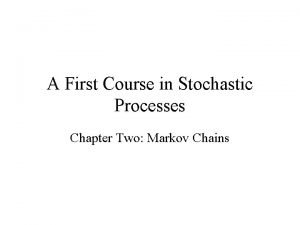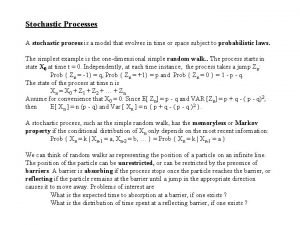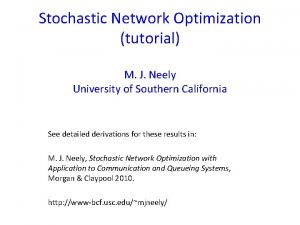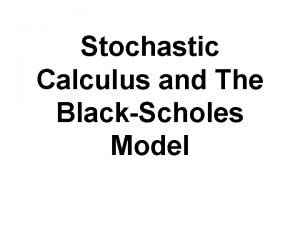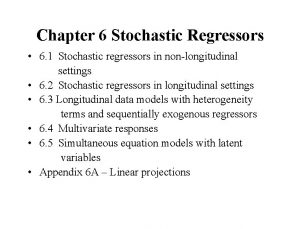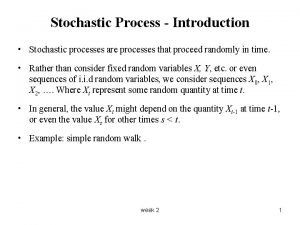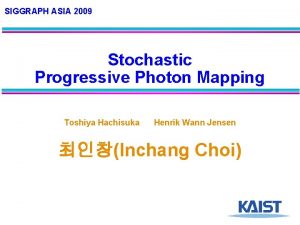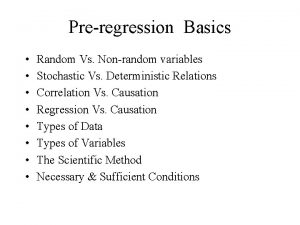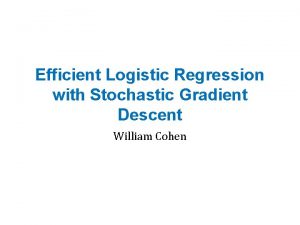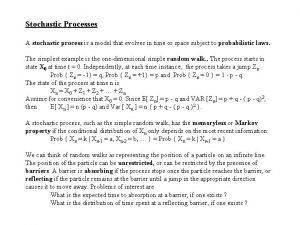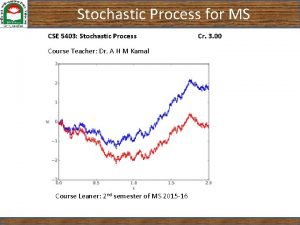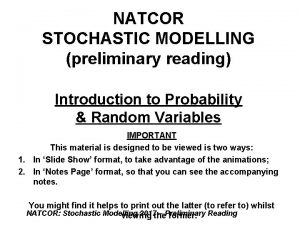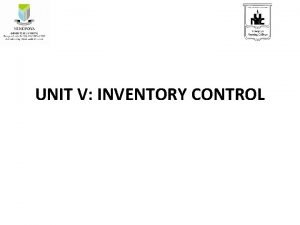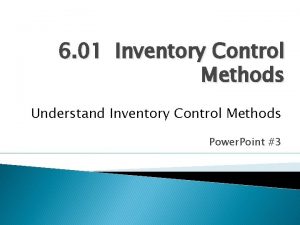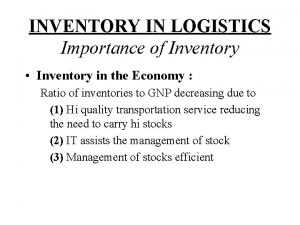NATCOR Stochastic Modelling Course Inventory Control Part 3



















- Slides: 19

NATCOR Stochastic Modelling Course Inventory Control – Part 3 Adam Letchford Department of Management Science Lancaster University Management School

Multi-Item Problems • So far, we have only considered problems in which there is a single product type (“item”) to order. • In real life we typically have many items to order. • This leads to some complications. • We now briefly consider three commonly-used multiitem models. • For simplicity we assume demand is deterministic. • We let n denote the number of items.

Variant I: Shared Space • Let item i have annual demand Di, order cost Co(i) and annual holding cost Ch(i). • We may also have lower bounds li and upper bounds ui for the delivery quantities. • Now suppose that one unit of item i takes up si space, and the total space available is S. • Each item must be ordered at regular intervals.

Variant I: Shared Space (cont. ) If order quantity for item i is Qi, then: • number of times i ordered per year is Di/Qi • annual ordering cost for i is Co(i) Di/Qi • average amount of i in stock is Qi/2 • annual cost of holding i in stock is Ch(i) Qi/2.

Variant I: Shared Space (cont. ) So we need to solve the Nonlinear Programme: This NLP is convex and can be solved efficiently (see Ziegler, 1982).

Variant II: Clustered Items • Now forget about the issue of shared space. • Suppose that the company wish to make inventory control easier by grouping the items into k “clusters”. • We are free to choose integers T 1, …, Tk so that items in cluster i are ordered every Ti time units. • E. g. , items in cluster 1 ordered every 4 weeks, items in cluster 2 ordered every 7 weeks, etc. • The optimal clustering can be computed efficiently, by dynamic programming (Chakaravarty, 1981).

Variant III: Joint Replenishment Now suppose that the n items all come from the same supplier. Then, if several different items are delivered at the same time, there may be a discount. One way to model the discount structure is to suppose that we have a “major” delivery cost M, together with a “minor” delivery cost mi for each item i. The cost of a delivery is then the major cost plus the sum of the relevant minor costs.

Variant III: Joint Replenishment (cont. ) • The resulting problem is called the Joint Replenishment Problem (JRP). • It can be formulated as a mixed-integer nonlinear programme. • It is “NP-hard”, which makes it unlikely that an efficient algorithm exists for all instances. • But some good heuristics exist. • See the survey Khouja & Goyal (2008).

And now for something completely different…

A “One-Off” Model: the Newsboy Problem • At the start of each day, a newsboy must decide on the number of papers to purchase. • Daily sales are stochastic, and are represented by the random variable x. • Purchasing one copy costs p. • Selling one copy yields revenue r (> p). • Scrapping an unsold copy costs s. • How many copies should he purchase?

Newsboy Problem (cont. ) It is helpful to compute: • Unit cost of over-stocking = co = p + s • Unit cost of under-stocking = cu = r – p. (Note: if desired, one can also attempt to incorporate “loss of customer goodwill” by increasing cu. )

Newsboy problem: cost function Suppose he orders Q copies. For a given demand x, • Cost of over-stocking = co × Max {0, Q – x} • Cost of under-stocking = cu × Max {0, x – Q}. So we wish to choose the value Q that minimises the expected value of : co Max {0, Q – x} + cu Max {0, x – Q}.

Newsboy problem: cost function (cont. ) Therefore if f(x) is the probability density function for the demand variable x, we wish to minimise the function: To find such a minimum, we need to set the derivative of g(Q) to zero!

Newsboy problem: solution Now, Leibnitz’ rule states that… And therefore = co F(Q) - cu (1 – F(Q)), where F(. ) is the cumulative density function.

Newsboy problem: solution (cont. ) So for a minimum we need co F(Q) - cu (1 – F(Q) = 0, or, equivalently, F(Q) = cu/(co + cu). So just compute cu/(co + cu) and then find the desired value of Q (e. g. , from Normal tables).

Newsboy problem: visualisation

Newsboy problem: final remarks To be sure that we have a minimum, we should check that the second derivative of g(Q) is positive for our chosen value of Q. In fact, the second derivative is (co + cu) f(Q), which is always positive. Therefore not only do we have a minimum, but we know that g(Q) is a convex function.

References I: Books • W. J. Hopp & M. L. Spearman (2011) Factory Physics (3 rd edn. ) • S. Nahmias (2008) Production & Operations Analysis (6 th edn. ) • E. Porteus (2002) Foundations of Stochastic Inventory Theory. • E. A. Silver, D. F. Pyke & R. Peterson (1998) Inventory Management and Production Planning and Scheduling (3 rd edn. ) • D. Sipper & R. L. Bulfin Jr (1997) Production: Planning, Control and Integration.

References II: Papers • A. K. Chakaravarty (1981) Multi-item inventory aggregation into groups. J. Oper. Res. Soc. , 32, 19 -26. • F. W. Harris (1913) How many parts to make at once. Factory, The Magazine of Management, 10, 135 -136, 152. • M. Khouja & S. Goyal (2008) A review of the joint replenishment problem literature: 1989– 2005. Eur. J. Oper. Res. , 186, 1 -16. • H. Ziegler (1982) Solving certain singly constrained convex optimization problems in production planning. Oper. Res. Lett. , 1, 252– 256.
 Deterministic demand vs stochastic demand
Deterministic demand vs stochastic demand Deterministic and stochastic inventory models
Deterministic and stochastic inventory models A first course in stochastic processes
A first course in stochastic processes Thecb course inventory
Thecb course inventory Stochastic rounding
Stochastic rounding Stochastic programming
Stochastic programming Asynchronnous
Asynchronnous Divbar
Divbar Put call formula
Put call formula Stochastic vs dynamic
Stochastic vs dynamic Stochastic matrix
Stochastic matrix Stochastic regressors
Stochastic regressors Non stochastic theory of aging
Non stochastic theory of aging Stochastic process introduction
Stochastic process introduction Stochastic progressive photon mapping
Stochastic progressive photon mapping Known vs unknown environment
Known vs unknown environment Discrete variable
Discrete variable Logistic regression stochastic gradient descent
Logistic regression stochastic gradient descent Stochastic process modeling
Stochastic process modeling Stochastic process
Stochastic process


